Release 3.1
Part Number E14597-03
Contents
Previous
Next
| Oracle Application Management Pack for Oracle E-Business Suite User's Guide Release 3.1 Part Number E14597-03 | Contents | Previous | Next |
With Oracle Enterprise Manager 10g Grid Control you can define one or more service models that represent the business functions or applications in your enterprise. You can define these service models by creating one or more service tests that simulate common end-user functionality. Using these service tests, you can measure the performance and availability of critical business functions, receive alerts when there is a problem, identify common issues and diagnose causes of failures. Monitoring a service helps you ensure that your operational goals and service level agreements are met. Refer to the Oracle Enterprise Manager Concepts for more information on the concepts of service management.
You can define a Web application service to monitor Web transactions. A Web application target consolidates all the components of your Web application and determines the availability, performance and usage of the application.
The availability of the Web application can be defined in terms of availability of the Web transactions that are being monitored. For Web applications, Web transactions represent the service tests. A Web application is available as long as the critical functions such as generating a sales report or an online purchase can be performed. Beacons are used to monitor the Web transactions from different geographical locations. You can designate one or more beacons as the "key beacons" that will be used to run the Web transaction. The Web transaction is considered available if it can be executed successfully by any of the key beacons. A Web application can have multiple "key Web transactions" defined. One or more key Web transactions can be used to monitor the availability of the Web application.
Go through the following steps to define your own Web applications for monitoring your key Web transactions.
Create an Oracle E-Business Suite user for beacon monitoring and playback
In your Oracle E-Business Suite system, create an Oracle E-Business Suite user for beacon monitoring and playback from Enterprise Manager. Ensure that this user has all the responsibilities required to perform the Web transactions that you will be recording.
Update Fixed Key profile options
Set profile "FND: Fixed Key Enabled" to "Yes" for the Oracle E-Business Suite user created above.
Set profile "FND: Fixed Key" to a hexadecimal String of length 64 for the Oracle E-Business Suite user created above. Example "AAAA....A" (x64).
Set the profiles "FND: Fixed Key Enabled" to "Yes" and "FND: Fixed Key" to the same value as set in item (2) above for the Guest user. The Guest user is determined by the profile "GUEST_USER_PWD" and is typically the user "GUEST".
You can create a Web application service to record Web transactions for monitoring as follows.
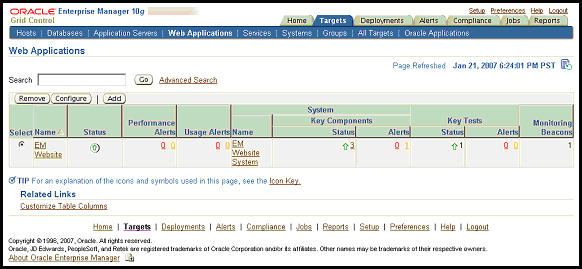
Follow the steps in the Create Web Application wizard to create a Web application service and record Web transactions that represent the service tests for the Web application. At any step in the wizard, you can click on the global “Help” link to get detailed information and instructions for that step.
In the “General” step of the wizard, if you decide to select a system that hosts the Web application service, you can select the system of type “Oracle E-Business Suite System” for your Oracle E-Business Suite system.
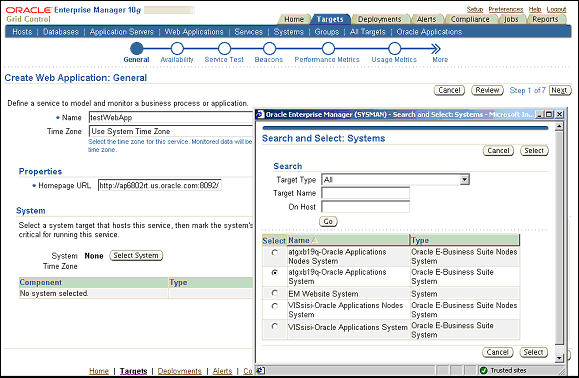
In the “Availability” step of the wizard, choose “Service Test” to determine the availability of the Web application service based on the key Web transactions.
In the “Service Test” step of the wizard, you can record a Web transaction by following the instructions on the page. When recording the transaction, log in to the Oracle E-Business Suite system as the Oracle E-Business Suite user and navigate to the related pages in order to perform the Web transaction. After recording, click on the Verify button to playback the recorded transaction in the browser.
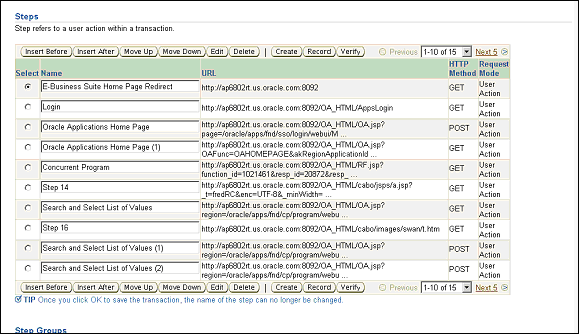
In the “Beacons” step of the wizard, add or create beacons that will monitor and playback the Web transaction. You can also select one or more beacons and verify the service test from those beacons.
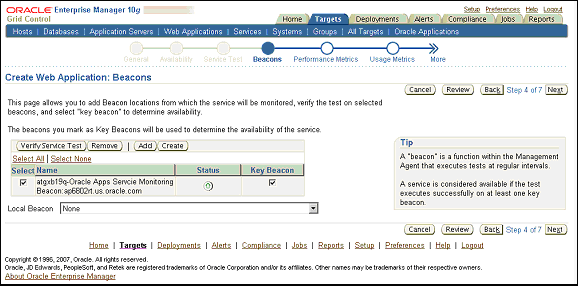
You can monitor your recorded Web transactions by clicking on the Web applications service.
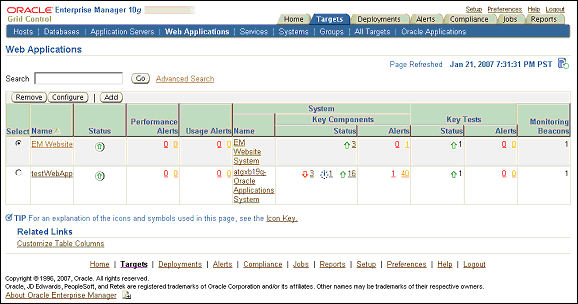
If you selected “Service Test” for determining availability of the Web application, the status of the Web application service will be based on the status of the Web transactions that comprise the key tests for that service.
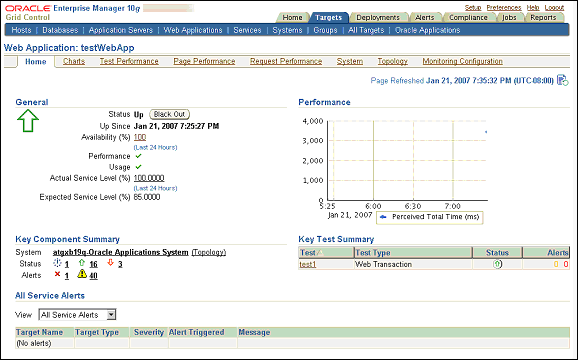
You can also navigate to the “Test Performance” subtab to view the performance of each key test as measured from each of the key beacons.
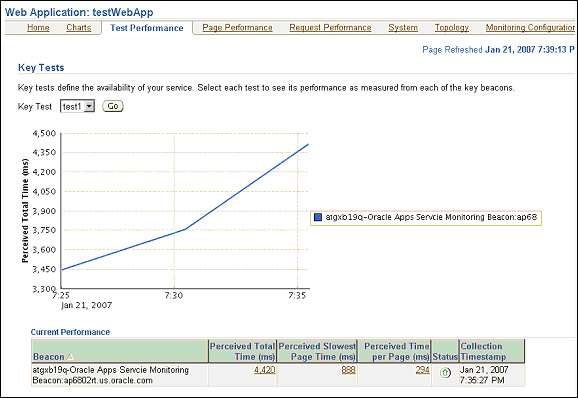
The Application Management Pack provides an “Order Management - Order Information Portal” service with an example Web transaction. In order to enable this service, you can follow these steps.
Create an Oracle E-Business Suite user for beacon monitoring and playback.
In your Oracle E-Business Suite system create an Oracle E-Business Suite user for beacon monitoring and playback from Enterprise Manager. Assign the "OAM EM Service Monitor" responsibility to this user.
Update Fixed Key profile options.
Update the Fixed Key profile options described above for the user you just created. Set the profile "FND: Fixed Key" to a hexadecimal String "AAAA....A" (of length 64).
Note: You must set the “FND: Fixed Key” profile to this specific key value in order to enable the out-of-box example.
Discover the Oracle E-Business Suite system.
Register your Oracle E-Business Suite System with Enterprise Manager as described in the chapter Discovering Oracle E-Business Suite Systems with Grid Control. After choosing the relevant database, in addition to the Monitoring Schema and Monitoring Schema Password, specify values for the Monitoring Applications Username and Monitoring Applications User Password. The Monitoring Applications Username and Monitoring Applications User Password fields should contain the credentials for the Applications user created in the step above.
Enable the example Web transaction.
After registering the Oracle E-Business Suite system, from the Oracle Applications target home page, select the Order Management − Order Information Portal target.
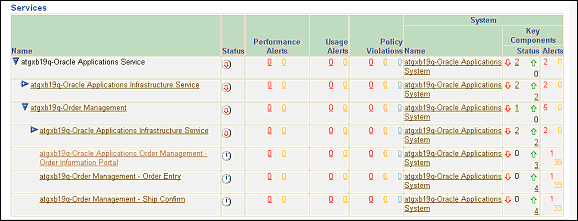
Enable the service tests under Monitoring Configuration page of the service.
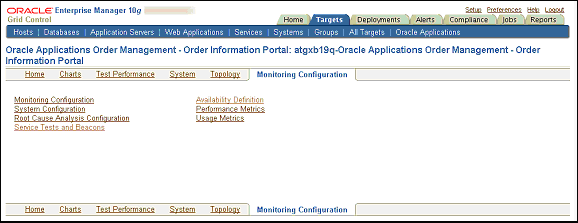
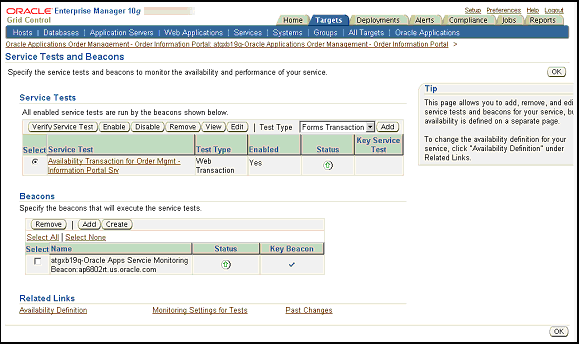
Define the availability of the Order Information Portal service by selecting the key test and key beacons. To do this, follow this navigation path: Oracle Applications Order Management - Order Information Portal page > Monitoring Configuration tab > Availability Definition link.
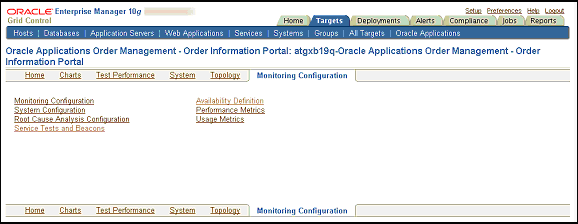

![]()
Copyright © 2007, 2010, Oracle and/or its affiliates. All rights reserved.